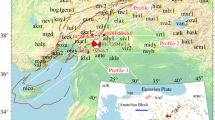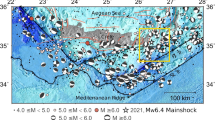Summary
Using about 100 earthquakes recorded on both the short-period and long-period matched three-component seismograph systems at Umeå (UME) in northern Sweden, relativeP-wave travel times (LP-SP) are measured and arrival angles (incidence and azimuth) are determined from relative amplitudes ofP. Long-period onsets appear to register consistently later than short-period ones by a couple of tenths of a second. This figure is of the same order as the uncertainty in δT LS (difference between LP and SP onset times), but still is shown to be of some statistical significance. The effect is believed due, at least in part, to the relative inability of the long-period seismometer to visibly register an initial shorter-period lower-amplitude focal phase from some earthquakes.
The dip on crustal interfaces implied by the short-period azimuth and incidence-angle anomalies is 7 to 15 times greater than that implied by the long-period anomalies. This effect is believed due to undulation or irregularity of, foremost, the Moho, as well as other crustal boundaries. The ‘wavelength’ of, say, Moho undulations would seem to be limited above and below by considerations of the dominant long-period wavelengths (∼100 km) and of the ‘diameter’ of Moho sampled by the short-period waves (∼50 km). The possible ‘undesirable’ effect of the crustal layering on the components of surface motion, and thus on the arrival angles, is discussed and cautiously dismissed, due to the absence of sedimentary layering, in favour of the above interpretation.
Similar content being viewed by others
References
B. Akasche,Vergleichende Untersuchung des mechanischen Vorgangs in Erdbebenherden aus Aufzeichnungen kurzperiodischer und langperiodischer Seismographen, Doctoral dissertation, Naturwiss. Fak., Goethe Univ., Frankfurt am Main (1968), 154 pp.
M. Båth,Seismology in Sweden 1963–1967, Report pres. to Zurich IASPEI Assembly,in Comptes Rendus 15 bis of IASPEI (1967), 28 pp.
M. Båth,Average crustal structure of Sweden, Pure and Appl. Geophys.88 (1971), 75.
P. Bormann,Statistische Untersuchungen zur Ortung teleseismischer Ereignisse aus Raumwellenregistrierungen der Station Moxa, Veröff. Zentralinst. Phys. Erde, Berlin, Nr. 9 (1971), 103 pp.
R. J. Brown,Lateral inhomogeneity in the crust and upper mantle from P-wave amplitudes, Pure and Appl. Geophys. (in press, 1972).
R. J. Brown,Azimuthally varying P-wave travel-time residuals in Fennoscandia and lateral inhomogeneity, Pure and Appl. Geophys. (in press, 1973).
R. J. Brown,Slowness and azimuth at the Uppsala array, part 2: structural studies, Pure and Appl. Geophys. (in press, 1973).
R. M. Clowes, E. R. Kanasewich andG. L. Cumming,Deep crustal seismic reflections at nearvertical incidence, Geophysics33 (1968), 441.
R. J. W. Douglas,Summary of the geology of Canada, inThe Earth sciences in Canada, Earth-Sci. Rev.8 (1972), 81.
R. M. Ellis andP. W. Basham,Crustal characteristics from short-period P waves, Bull. Seism. Soc. Am.58 (1968) 1681.
M. A. Enayatollah,Travel times of P-waves for the Swedish-Finnish seismograph network, Pure and Appl. Geophys.94 (1972), 101.
M. Ewing, S. Mueller, M. Landisman andY. Satô,Transient analysis of earthquake and explosion arrivals, Geofis. Pura e Appl.44 (1959), 83.
R. A. Fisher,Statistical Methods for Research Workers, 11th edition (Oliver and Boyd Ltd., Edinburgh 1950), 354 pp.
W. I. Futterman,Dispersive body waves, J. Geophys. Res.67, (1962), 5279.
B. Gutenberg,Physics of the Earth’s Interior (Academic Press, New York and London 1959), 240 pp.
D. H. Hall andZ. Hajnal,Crustal structure of northwestern Ontario: refraction seismology, Can. J. Earth Sci.6 (1969), 81.
H. S. Hasegawa,Crustal transfer ratios of short- and long-period body waves recorded at Yellow-knife, Bull. Seism. Soc. Am.61 (1971), 1303.
N. A. Haskell,Crustal reflection of plane P and SV waves, J. Geophys. Res.67 (1962), 4751.
E. Herrin, E. P. Arnold, B. A. Bolt, G. E. Clawson, E. R. Engdahl, H. W. Freedman, D. W. Gordon, A. L. Hales, J. L. Lobdell, O. Nuttli, C. Romney J. Taggart andW. Tucker,1968 seismological tables for P phases, Bull. Seism. Soc. Am.58 (1968), 1193.
H. M. Iyer andJ. H. Healy,Teleseismic residuals at the LASA-USCGS extended array and their interpretation in terms of crust and upper mantle structure, J. Geophys. Res.77 (1972), 1503.
H. Jeffreys andK. E. Bullen,Seismological Tables, Brit. Assoc. Adv. Sci., Gray Milne Trust, London (1967), 50 pp.
P. Mechler,Direct determination of the thickness of the Earth’s crust by travel time studies, Phys. Earth and Planet. Interiors2 (1969), 93.
R. F. Mereu andG. Jobidon,A seismic investigation of the crust and Moho on a line perpendicular to the Grenville Front, Can. J. Earth Sci.8 (1971), 1553.
O. Nuttli,Some observations relating to the effect of the crust on long-period P-wave motion, Bull. Seism. Soc. Am.54 (1964), 141.
O. W. Nuttli,Table of angles of incidence of P waves at focus, calculated from 1968 P tables, Earthq. NotesXL 3 (1969), 21.
O. W. Nuttli andB. A. Bolt,P wave residuals as a function of azimuth 2. Undulations of the mantle low-velocity layer as an explanation, J. Geophys. Res.74 (1969), 6594.
M. Otsuka,Azimuth and slowness anomalies of seismic waves measured on the central California seismographic array. Part II. Interpretation, Bull. Seism. Soc. Am.56 (1966), 655.
R. A. Phinney,Structure of the Earth’s crust from spectral behavior of long-period body waves, J. Geophys. Res.69 (1964), 2997.
R. A. Phinney andS. W. Smith,Processing of seismic data from an automatic digital recorder, Bull. Seism. Soc. Am.53 (1963), 549.
A. M. Rogers, Jr., andC. Kisslinger,The effect of a dipping layer on P-wave transmission, Bull. Seism. Soc. Am.62, (1972), 301.
T. J. Smith, J. S. Steinhart andL. T. Aldrich,Lake Superior crustal structure, J. Geophys. Res.71 (1966), 1141.
M. R. Spiegel,Theory and Problems of Statistics (Schaum’s outline series) (McGraw-Hill Book Co., New York 1961), 359 pp.
W. Stauder,The Alaska earthquake of July 10, 1958: seismic studies, Bull. Seism. Soc. Am.50 (1960), 293.
S. Suyehiro,Pseudo dispersion in body waves and unusual region near northeast Japan, Papers in Meteorol. and Geophys.XXI (1970), 459.
T. Utsu,Variations in spectra of P waves recorded at Canadian Arctic seismograph stations, Can. J. Earth Sci.3 (1966), 597.
G. Willey, J. R. Cleary andP. D. Marshall,Comparison of least squares analyses of long and short period P wave amplitudes, Geophys. J. R. Astr. Soc.19 (1970), 439.
Author information
Authors and Affiliations
Rights and permissions
About this article
Cite this article
Brown, R.J., Enayatollah, M.A. Comparison of short- and long-periodP-wave travel times and arrival angles. PAGEOPH 109, 1638–1652 (1973). https://doi.org/10.1007/BF00876090
Received:
Issue Date:
DOI: https://doi.org/10.1007/BF00876090




